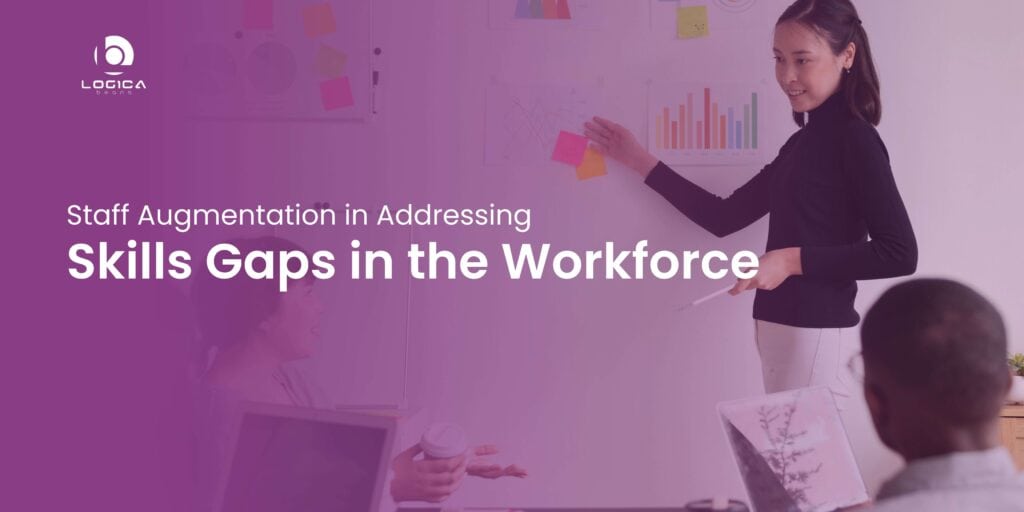The fast speed of technological innovation and shifting market needs have resulted in a considerable skills gap in the workforce. Companies are struggling to recruit qualified individuals to fill critical tasks, resulting in a skilled professional shortage across a variety of industries. To solve this issue, firms are looking to staff augmentation as a solution. Staff augmentation is a personnel technique that enables firms to swiftly and flexibly add competent experts to their teams. This technique allows enterprises to access a diverse pool of personnel, which may help bridge the skills gap and enable organizations to compete more successfully.
In this blog, we will explore the role of staff augmentation in addressing skills gaps in the workforce, the benefits of this approach, and the factors to consider when using staff augmentation.
Concept of staff augmentation
Staff augmentation is a business approach that entails temporarily recruiting outside expertise or resources to complement the existing staff and suit specific company demands. It essentially allows businesses to swiftly grow their capacity, cover skill shortages, and finish projects without the expenditure and commitment of recruiting full-time staff. This strategy allows firms to concentrate on their core strengths while delegating non-core work to specialized teams or people. Staff augmentation is widely employed in fields such as information technology, engineering, and healthcare, to name a few.
Staff augmentation gives you access to specialized skills that you might not have in-house. For example, if a corporation has to build a new software product but lacks the required skills, it might engage a temporary team of software engineers. These developers may contribute their skills, expertise, and experience to ensure that the project is completed efficiently and successfully.
Furthermore, staff augmentation can be a cost-effective choice for businesses who lack the means to acquire full-time personnel or keep a big workforce. Businesses can save money on salaries, benefits, and other overhead expenditures by outsourcing non-core services to external teams or individuals.
Staff augmentation, on the other hand, necessitates careful planning and supervision to ensure that the external talent integrates smoothly with the current team and adheres to the company’s standards and procedures. When dealing with external professionals, communication, cooperation, and openness are critical to success, and it is critical to establish clear expectations, roles, and obligations from the start.
Staff augmentation is a successful technique for firms that need to swiftly adjust to changing market conditions, get access to specialized expertise, and effectively control expenses. Companies may achieve their objectives and remain competitive in their respective sectors by harnessing external resources.
Overview on skills gaps
The contrast between the abilities that employees have and the skills that employers demand is referred to as the skill gap. It arises when there is a mismatch between the skills of the workforce and the skills required to satisfy the labor market’s needs. Technical skills, emotional skills, industry-specific skills, and digital literacy are all examples of skill gaps. Addressing skill gaps is crucial for firms to stay competitive and people to be employable in today’s fast-paced, ever-changing employment market.
In today’s marketplace, skills shortages provide a significant barrier for both people and companies. Rapid technological improvements, fluctuating market demands, and changes in industry trends have resulted in a scenario in which employee’s skills can be insufficient to satisfy the needs of the labor market.
Employees’ skills gap can be the barrier to advancement and can limit their work possibilities. For example, if a person lacks the technical skills necessary to operate in a specific industry, they can find it difficult to obtain a job or be limited in the sorts of tasks they can apply for. Similarly, if a individual lacks a soft skill such as communication or problem-solving, they can struggle to work successfully in teams or achieve outcomes in a fast-paced and complicated work environment.
Employers’ capacity to develop and react to changing market needs can be hampered by talent shortages. If a business lacks individuals with the appropriate technical abilities, it can struggle to establish effective teams, manage projects or produce outcomes.
To address skill gaps, a multifaceted approach involving training, education and workforce development activities is required. Organizations can engage in employee training programs, mentorship efforts, and professional development opportunities to assist their workers gain the skills required to thrive in their professions. Furthermore, governments might engage in education and workforce development projects to assist individuals in acquiring the skills required for employment success.
Staff augmentation can also be an effective technique for resolving workforce skill shortages. Staff augmentation can help firms overcome acute skill shortfalls or offer continuous support for crucial initiatives by giving them access to specialized experience and abilities. Furthermore, temporary or contract workers are often seasoned experts who require less training and integration into the firm, which may assist organizations save training and onboarding expenses.
Skill gaps are a key concern for both individuals and employers in today’s employment market. Addressing skill shortages necessitates a multifaceted strategy that includes training, education, and workforce development activities. Staff augmentation may also be an effective technique for filling skill shortages by giving firms access to specific knowledge and abilities. Addressing skill gaps allows firms to remain competitive in the market, and people to remain employable and progress their careers.
Current skills gaps in the workforce
There are various skill gaps in today’s constantly evolving work market, making it challenging for companies to recruit the proper people. When the demand for certain abilities exceeds the supply of available talent, a scarcity of competent individuals for specific employment roles results.
Some of the most notable skills gaps are:
● Technical skills
The advent of new technologies such as artificial intelligence, machine learning, and data analytics has increased the demand for technical people. These technologies are changing the way organization’s function, and businesses are increasingly depending on qualified employees to create and implement solutions based on them.
Programming is one of the major areas where technical talents are in great demand. With the expansion of software applications and web-based services, there is an increasing demand for developers fluent in programming languages such as Python, Java, and C++. These developers are in charge of creating and developing software systems that can do everything from managing data to automated procedures.
● Soft skills
Employers are increasingly looking for applicants with good communication, cooperation, problem-solving, and creative abilities in today’s workplace. These abilities are required for effective team development, project management, and results delivery.
Communication abilities are very crucial since they are required for transmitting ideas, forming relationships, and resolving issues. Effective communication skills enable professionals to explain their ideas clearly, comprehend the viewpoints of others, and collaborate to accomplish common goals.
Collaboration abilities are very highly regarded since they allow employees to work successfully in groups, exchange knowledge, and achieve joint goals. Collaboration includes active listening, sharing ideas, and supporting others, all of which are required for effective team development.
● Industry specific skills
Many sectors demand specialized knowledge and abilities that are in limited supply, resulting in a qualified candidate scarcity for certain employment categories. This scarcity may boost competition for talent and make it difficult for companies to recruit qualified workers.
Healthcare is one area that has seen a substantial skills deficit. Healthcare professionals such as nurses and doctors, as well as specialized healthcare workers such as radiology technicians and medical laboratory technologists, are in short supply. Several reasons contribute to this deficit, including an aging population, increased demand for healthcare services, and a lack of investment in healthcare education and training programs.
● Digital literacy
As businesses continue to embrace digital transformation, there is an increasing demand for personnel who are knowledgeable about digital technology and tools. Online marketing, social media management, and digital content development are examples of such talents.
The capacity to use digital technology and tools efficiently to achieve specified goals is referred to as digital literacy. Digital literacy is becoming a required skill set for all employees, regardless of job function or sector, in today’s digital world.
Online marketing is one area where digital literacy is very crucial. Companies are increasingly depending on digital marketing platforms to reach their customers as e-commerce grows. Search engine optimization (SEO), pay-per-click (PPC) advertising, and email marketing are examples of such talents. Employees who are skilled in these areas are valued.
● Language and cultural skills
Language and cultural skills are becoming increasingly vital for employees in today’s global business. Companies that operate on a worldwide scale require personnel who can successfully interact with clients, colleagues, and partners from many nations and cultures. Employees who are proficient in numerous languages and have worked in multicultural settings are included.
Language skills are especially crucial for businesses that operate in areas where numerous languages are spoken. Employees who know various languages may help firms communicate more effectively with their clients and partners in these countries, enhancing their capacity to create strong connections and achieve business goals.
Cultural abilities are extremely important in today’s global economy. Employees who understand the differences in cultural norms and expectations can assist firms in navigating diverse cultural environments. Employees who have worked in multicultural situations and can adjust their speech and conduct to varied cultural contexts are included.
How staff augmentation works in practice?
Staff augmentation works in practice by employing temporary or contract personnel to enhance an organization’s current workforce and address specific skill shortages. This strategy entails collaborating with a staffing agency or consulting business to locate people with the required skills and knowledge.
Typically, the process begins with a requirements assessment, in which the business identifies particular skill shortages and decides the sort of talent required. The staffing agency or consulting business will find individuals with the relevant skills and expertise based on this evaluation.
Once appropriate candidates have been discovered, they will be interviewed and evaluated to ensure that they fulfill the needs of the company. Following that, the employment agency or consulting business will give the organization a shortlist of individuals for consideration.
When a candidate has been chosen by the business, they are usually hired on a temporary or contract basis. The length of the engagement will be determined by the needs of the company, with some contracts spanning many months or even years.
The temporary or contract worker will operate alongside the company’s current personnel during the engagement, bringing their skills and knowledge to assist the organization accomplish its business objectives. They may work on special projects, cover a temporary skills shortage, or give continuing assistance in a certain field.
The staffing agency or consulting business will give assistance and monitoring during the engagement, ensuring that the temporary or contract worker is meeting the organization’s requirements and achieving outcomes. They may also offer training and development opportunities to assist temporary or contract workers to advance their skills and experience.
Overall, staff augmentation offers firms a flexible and cost-effective method to address workforce skill gaps. Organizations may swiftly bridge skills shortages and bring in the knowledge they need to meet their business objectives by recruiting temporary or contract workers with the relevant skills and expertise.
Role of staff augmentation in addressing skills gaps in the workforce
Staff augmentation can play an important role in addressing skill gaps in the workforce by providing organizations with access to specialized expertise and skills. By leveraging staff augmentation services, organizations can fill immediate skills gaps or provide ongoing support for key initiatives.
Here are some specific ways staff augmentation can address skill gaps:
● Access to the specialized skills and expertise
Staff augmentation enables businesses to swiftly gain access to specific skills that they may not have in-house. For example, if a company needs a data analyst with specialized talents in data visualization, it can recruit a contract worker with that knowledge. This allows firms to cover the immediate skills gap and complete the projects more efficiently.
● Flexibility and scalability
Staff augmentation enables firms to scale up or reduce their personnel as needed. This is especially useful for firms that may have fluctuating demand or that require specialized knowledge for certain projects. Staff augmentation enables businesses to swiftly add or remove staff to suit changing demands.
● Reduced trainings and onboarding costs
Staff augmentation employees are usually seasoned professionals that need less training and onboarding than new hires. This cuts down on the time and money required to train new personnel. Additionally, staff augmentation personnel can provide knowledge transfer and training to current employees, assisting in the closure of skill gaps and the development of internal expertise.
● Innovation and competitive advantage
Staff augmentation may assist a business foster innovation and create a competitive edge by bringing in new views and ideas. Organizations may remain ahead of industry changes and capitalize on new possibilities by bringing in people with specific skills and knowledge.
● Improved employee retention
By filling skills gaps through staff augmentation, organizations can improve employee retention by providing existing employees with the support and resources they need to be successful in their roles. This can lead to increased job satisfaction and loyalty among employees.
Examples on how staff augmentation helps in addressing skills gaps in the workforce
Staff augmentation has been successfully used in various industries to address skills gaps and meet the needs of specialized projects. Here are a few examples:
● Healthcare
A scarcity of nurses and other healthcare workers has created a skills space in the healthcare business. Staff augmentation has been utilized to fill this need by supplying temporary staff with specific healthcare knowledge. Healthcare businesses, for example, have employed staff augmentation services to bring in travel nurses who may work on a temporary basis to cover emergency staffing shortages.
● Technology
The technology business is continually growing, creating a demand for specific skills and knowledge. Staff augmentation has been employed in this business to give access to talented developers, data scientists, and other technical specialists. This enables firms to swiftly increase their staff and execute projects more effectively. Furthermore, staff augmentation might give access to specific expertise in new technologies like artificial intelligence or blockchain.
● Finance
Specialized knowledge and abilities in areas such as risk management, compliance, and financial analysis are required in the finance business. Staff augmentation has been utilized to fill skill gaps in this business by allowing temporary employees with these particular talents to work. Financial organizations, for example, have employed staff augmentation services to hire compliance officers who can assist assure regulatory compliance.
● Construction
The construction sector necessitates a wide range of skills, including project management, engineering, and construction management. In this business, staff augmentation has been employed to give temporary access to specific skills and knowledge. Construction firms, for example, have employed staff augmentation services to bring in project managers who can help oversee huge construction projects and guarantee that they are finished on time and on budget.
● Marketing
The marketing sector needs specific abilities in areas such as digital marketing, social media management, and content generation. Staff augmentation has been employed in this business to offer access to temporary personnel with these particular talents. Marketing firms, for example, have employed staff augmentation services to bring in social media professionals who can assist maintain social media accounts and develop interesting content.
Staff augmentation has been successfully used in various industries to address skills gaps and meet the needs of specialized projects. By providing access to specialized expertise, staff augmentation can help organizations remain competitive and adapt to changing market demands.
Conclusion
If you are looking to fill skill shortages in your workforce, consider staff augmentation as a viable option. Staff augmentation enables firms to have temporary access to specialized talent, which may assist bridge skills gaps and execute projects more effectively. You can stay competitive and adjust to shifting market needs by exploiting the benefits of workforce augmentation.
However, it is critical to properly assess your requirements and collaborate with a trustworthy staffing agency to ensure that you are acquiring the greatest available people for your unique need. Overall, staff augmentation may be a useful technique for filling talent shortages and attaining economic success.










